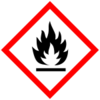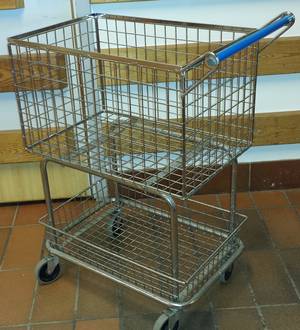5.2. Flammables
The legal situation
Usage and storage of flammable liquids and gases at Kemicentrum are controlled and supervised, by law, by the manager of flammables or his deputy, ("Föreståndare brandfarlig vara" and "ställföreträdare") at each unit/department. See list of names in Swedish at Systematiskt arbetsmiljöarbete: brandfarlig vara.
General explosion hazards in lab environment

Certain areas in the lab or around storage facilities and cupboards are EX-classified due to possible closeness to flammable solvents and gases.
In EX-classified areas it is not allowed to place or use non-EX-classified electrical equipment or any other ignition sources. Exception is lightning of a burner, that is allowed.
EX-classification plan for lab areas is displayed on the information board and must be studied before you start using the lab.
Areas with forced ventilation, such as in fume hoods, are the only areas that remain not classified as explosively hazardous during normal work with flammable solvent and burnable gases.
Regulations on handling of/working with flammable solvents and gases
The facilities in lab, arranged for handling flammable solvents and gases, such as fume hoods and storage cupboards, has been constructed and adjusted to fulfil the requirements by the ruling authorities.
It is not permitted to alter the facilities by individual adjustments. Malfunctions and poor adjustment should be reported to authorities.
Work with flammable solvents or gases must only be carried out in fume hoods or other workplaces with forced ventilation. Exceptions require that precautions have been taken so that the working area does comply with regulations on EX-classified zones.
Use only tap water cooling instead of pump circulated cooling during reflux boiling of flammable solvents.
Electrical equipment used in fume hoods...
- must only be connected to power sockets interlocked with the forced ventilation.
- marked with "EX" symbol is accepted to connect to standard power sockets.
- power socket connectors should never be placed inside, under or in front of the fume hood.
Regulations regarding storing flammable liquids
Flammable liquids and explosive mixtures must be kept in ventilated cupboards.
When storing chemicals you must consider the compatibility of different chemicals. For example, oxidizing chemicals must be kept separate from flammable liquids or other flammable chemicals. Chemicals that are both flammable and toxic should be stored as flammable chemicals. Chemical storage rooms and ventilated cupboards with flammables must be marked according to below.
As a general rule, the smallest possible quantities of these substances should be stored in the laboratory. The general recommendation is a maximum of 2.5 L.
A maximum of 50 L of flammable substances may be stored in ventilated cupboards in each fire cell boundary (check fire documentation). The only exception to this is laboratories in building I, which is equipped with fire sprinklers, in this case a maximum of 50 L of flammable liquids may be stored in ventilated cupboards in each laboratory.
Storing flammable substances in a standard refrigerator or freezer is prohibited. Use approved refrigerators/freezers for storing flammable substances.
Containers with flammable liquids must not be placed directly on the floor.
Plastic containers, larger than 2 L, must be type approved for the flammable liquid which is to be stored in the container.
Picric acid: max. 3 kg per storage room
Hydrogen peroxide with a concentration of ≥20%. Permitted storage volumes:
- Max. 1 L if the concentration is 80%.
- Max. 5 L if the concentration is 60% but lower than 80%.
- Max. 50 L if the concentration is lower than 60%.
Special permission is required in order to handle any amounts of hydrogen peroxide in concentration exceeding 60%.
Labels

Flammable material must be marked with this label.



Cupboards and storage rooms containing flammables must be marked with these labels.
Read more: 7. Signs and symbols.
Regulations regarding transporting flammable liquids

Transportation of volumes more than 1 L of highly flammable solvent/gases in areas outside the laboratory must be given the highest attention regarding safety.
Use a trolley with soft rubber wheels and fence to protect the goods during transport.
Single bottles can be transported upright in a plastic bucket or a similar container. Do not use the elevator while transporting flammable liquid chemicals.
Particular requirement on experimental work in case of evacuation and ventilation outage
In order to take into account the possibility for evacuation of Kemicentrum due to accidents, spills, exposures, ventilation outage, the following regulations must be considered for all experimental work. Before beginning any laboratory task, ensure there is a Risk assessment in place to deal with an emergency situation.
Risk assessments must include a confirmation on whether the experimental setup may or may not produce non-negligible volumes of flammable or explosive atmosphere if left for several hours without forced ventilation.
If it may produce non-negligible volumes of flammable or explosive atmosphere then:
- The experimental setup must be designed for this specific activity and supervised by staff.
- The risk assessment must include a time plan for sealing of the setup.
- In case of evacuation, the experimental setup must be sealed before evacuation (if this can be done without immediate risk of health).
Example 1
Flash chromatography, when using low boiling solvents that is collected in open sample tubes, always produce considerable amounts of flammable gases and must always be supervised so it can be sealed immediately in case of evacuation.
Example 2
Bottles containing solvent must never be left open to atmosphere and must always be closed in case of evacuation.
Example 3
Use of a continuous stream of flammable gas must be supervised and closed in case of evacuation or be equipped with an automatic valve that closes if ventilation ceases.
